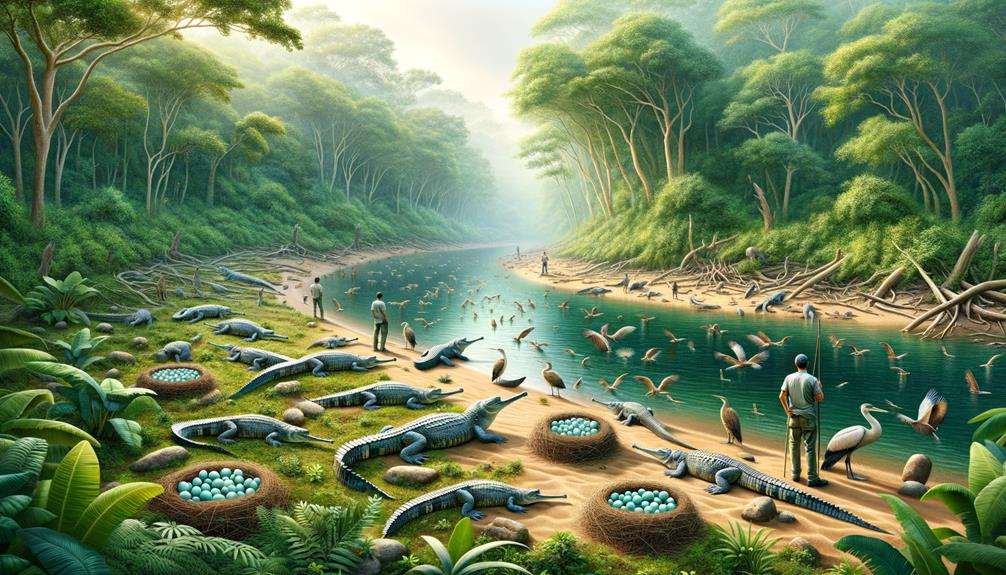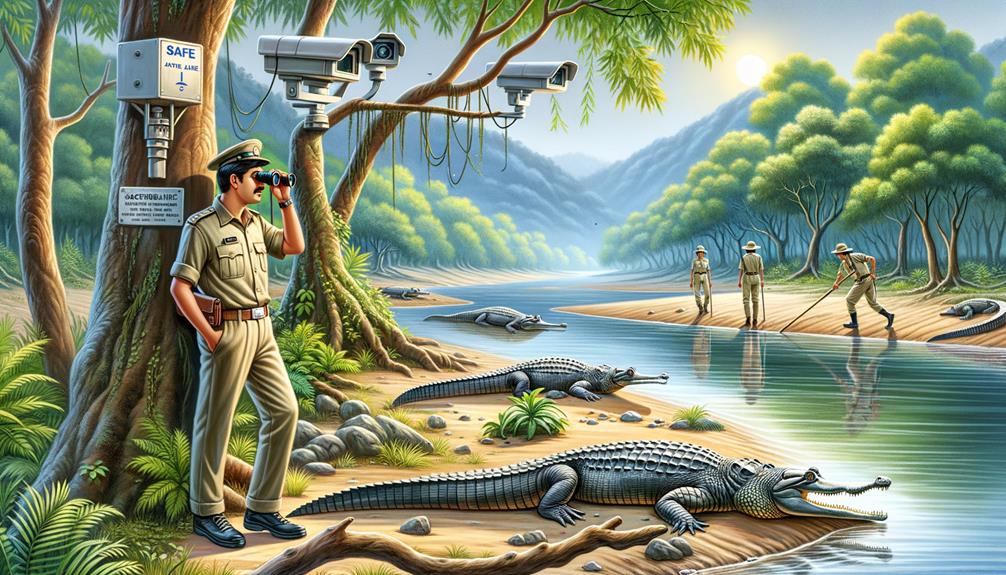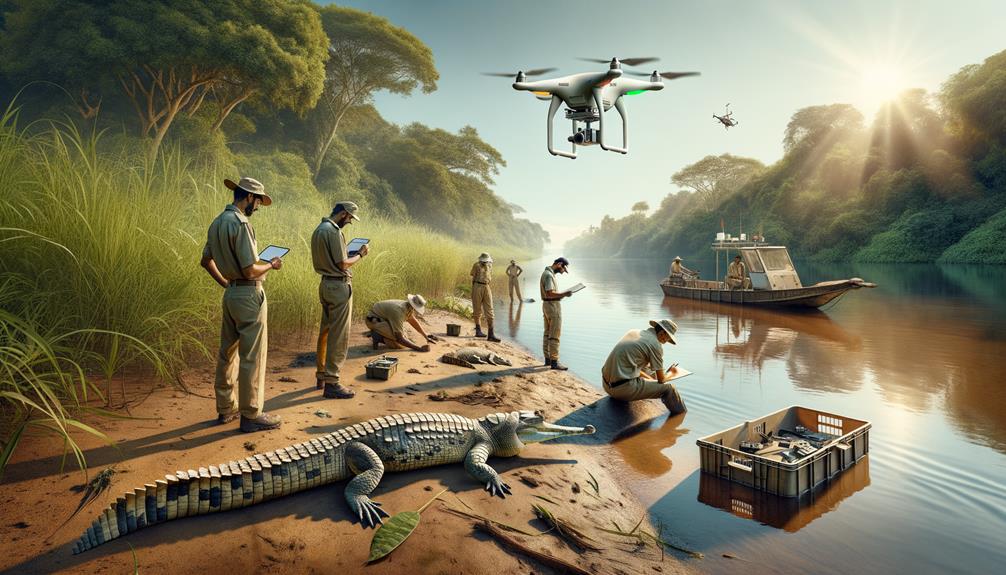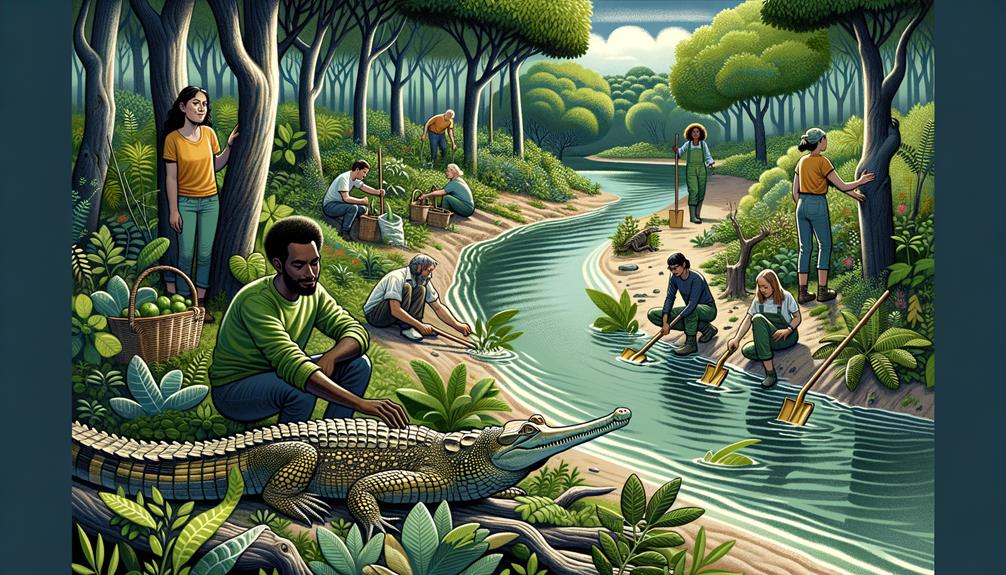India's conservation efforts are making a tangible impact on saving the critically endangered gharial. The National Chambal Sanctuary provides a safe haven for the majority of the world's wild population. Since the 1970s, breeding programs have helped increase their numbers from a few hundred to nearly a thousand today. Local communities are crucial in this process, working diligently on habitat restoration and monitoring. Combating poaching and illegal trade is a top priority, accompanied by ongoing research and tracking initiatives. These collaborative efforts offer promise for the gharial's survival. It's fascinating to see how these strategies work in tandem.
Key Takeaways
Conservation efforts for the Indian Gharial have made significant strides in protecting this endangered species. The National Chambal Sanctuary provides a safe haven for approximately 90% of the world's wild gharial population. Breeding and reintroduction programs have led to a substantial increase in gharial numbers, growing from just a few hundred to around 300-900 mature individuals.
Locals are actively involved in restoring and protecting gharial habitats through community engagement initiatives. Researchers employ satellite telemetry to track gharial movements and habitat use, informing conservation strategies. Addressing threats such as poaching, illegal trade, and environmental degradation is critical to ensuring the long-term survival of the Indian Gharial.
Establishing Protected Habitats
India's commitment to protecting gharials is crucial, and sanctuaries like the National Chambal Sanctuary play a vital role in safeguarding around 90% of the global wild population. By focusing on conservation, India ensures these unique crocodilians have a fighting chance for survival. The National Chambal River Sanctuary, established in 1979, has been instrumental in this effort. Here, researchers conduct extensive population surveys and captive breeding programs, directly influencing the gharial population.
Local communities have been essential in this conservation effort. By involving them in the process, they develop a sense of ownership and responsibility towards protecting the gharial's habitat. This collaborative approach is critical, especially since many populations still inhabit unprotected river stretches, making their survival precarious.
Breeding efforts within these sanctuaries, combined with wild restocking initiatives, aim to boost the population. The data gathered from population surveys helps refine these strategies, ensuring they are effective and adaptive. Fundamentally, the creation and maintenance of these protected areas, alongside proactive conservation measures, are vital to the future of the gharial in India. This comprehensive strategy highlights India's dedication to preserving its natural heritage.
Breeding and Reintroduction Programs

Building on the success of protected habitats, breeding and reintroduction programs have become crucial in securing the future of the gharial population. The Gharial Conservation Breeding Program, launched in the 1970s, has played a significant role in this effort. By establishing breeding centers like the Kukrail Gharial Rehabilitation Center in Uttar Pradesh and Nandankanan Zoological Park in Odisha, we've significantly increased gharial numbers.
Raising juvenile gharials in captivity for 2-3 years before releasing them into their natural river habitats has been a key strategy. This approach has helped boost populations from a few hundred in the 1970s to around 300-900 mature individuals today. However, habitat loss and the lack of long-term monitoring have impacted some reintroduced populations.
Our conservation efforts extend beyond breeding and reintroduction. We've conducted extensive population surveys to track progress and identify critical areas within the river system that need protection. Educating the public and engaging local communities are also vital components, ensuring that the gharial's protected status is respected and upheld. Through these multifaceted efforts, we're working to secure a future where gharials can thrive.
Tackling Poaching and Illegal Trade

Poaching and illegal trade are major threats to the gharial's survival, and urgent action is needed to protect this critically endangered species. The demand for gharial eggs and skin, used in traditional medicine and luxury goods, continues to drive their decline. Longlines used by turtle poachers often trap and kill baby gharials, further depleting the population.
Law enforcement efforts are hindered by the remote locations of gharial habitats, making it difficult to curb these illegal activities. However, working with local communities in gharial regions can enhance conservation efforts. By empowering these communities, we can improve monitoring and protection measures.
To combat poaching and illegal trade effectively, we need to:
- Engage local communities in anti-poaching patrols to monitor gharial populations and safeguard breeding areas.
- Address sand mining and fishing practices that deplete food sources and destroy nesting sites, improving habitat conditions.
- Launch targeted campaigns to reduce demand for traditional medicine and luxury goods, making illegal trade less profitable.
- Integrate captive breeding programs with wild conservation efforts, safely reintroducing gharial eggs into the wild.
These strategies are crucial to ensuring the gharial population can recover and thrive.
Community Engagement and Education

While addressing poaching and illegal trade is crucial, engaging and educating local communities is vital to sustainable gharial conservation efforts. The Gharial Conservation Alliance recognizes that the survival of these critically endangered reptiles relies heavily on the active participation of people living along the riverbanks. By involving local communities in monitoring and protecting gharials, we can create a network of guardians for these ancient creatures.
Raising awareness about the importance of gharials and their ecosystems fosters a sense of responsibility among residents. Public awareness campaigns highlight the threats, such as poaching and overfishing, and emphasize the need for conservation. Through these efforts, communities develop a deeper understanding of their role in preserving local biodiversity.
Local residents are actively involved in habitat restoration, removing man-made structures, and planting native vegetation along the river. This cooperation with local stakeholders is vital for the long-term success of research and conservation efforts. When communities are engaged and educated, they become the first line of defense, ensuring the delicate balance of their river ecosystems remains intact.
Monitoring and Research Initiatives

When I examine the current monitoring and research initiatives, I see the value of thorough population surveys and satellite telemetry studies. These tools enable us to track gharial movements and habitat use, while also providing insights into nesting behaviors and hatchling survival rates. By combining these findings with habitat assessments, we can develop more effective conservation strategies that ensure the gharials' survival.
Population Tracking Methods
In our efforts to conserve the Indian gharial, we've developed a range of sophisticated population tracking methods that provide crucial insights into their numbers, movements, and reproductive success. These methods are vital for informing both captive breeding and wild restocking programs, ensuring the survival of released gharials.
We take a multi-faceted approach, which includes:
- Regular Population Surveys: Scientific surveys help us monitor gharial populations in key habitats like the Chambal River, allowing us to track changes and identify trends.
- Satellite Tracking: By attaching transmitters to adult gharials, we can analyze their movement patterns and habitat use, which is key to understanding their ecology and improving conservation strategies.
- Mark-Recapture Methods: These enable us to estimate population size, age structure, and recruitment rates, giving us a comprehensive picture of the gharial population.
- Genetic Studies: Collecting and analyzing genetic samples helps us evaluate the population structure and genetic diversity, reducing the threat of inbreeding.
Each of these methods provides a detailed and nuanced picture of the gharial populations. By understanding the challenges they face, such as turtle poaching and habitat disruption, we can tailor our conservation efforts to be more effective. Our ultimate goal is to secure a future where these majestic creatures thrive in the wild.
Habitat Analysis Techniques
To fully understand and protect gharial habitats, we employ advanced tools like satellite imagery, GIS, and remote sensing techniques to monitor and assess their environments across India and Nepal. These habitat analysis techniques are crucial for identifying critical areas where gharials, a fish-eating crocodile, thrive, particularly in shallow areas essential for nesting.
Using satellite imagery and GIS, we map and track changes in habitat quality over time, providing a comprehensive understanding of aquatic vegetation and prey fish populations. This detailed analysis enables us to respond swiftly to environmental threats that could jeopardize the gharial's survival.
Radio-telemetry and GPS-based tracking of captive-bred gharials released into the wild offer valuable insights into their movement patterns and habitat use. This data is vital for evaluating the success of restocking programs, informing future reintroductions, and ensuring that these critically endangered creatures can adapt and flourish in their natural settings.
Examining the nesting ecology, including nest site selection and gharial eggs' hatchling survival rates, helps refine our conservation strategies. These efforts, coordinated with the GCA, are central to safeguarding the future of the gharial.
Addressing Environmental Threats

Conservationists must take immediate action to address the environmental threats that are pushing Indian gharials to the brink of extinction. Excessive fishing and the use of nets are depleting their prey population and causing gharials to drown. Sand and boulder mining are disrupting their nesting sites, while dams are altering river flows and affecting hatchling survival. River interlinking projects are further threatening their habitats, and feral dogs are preying on their eggs, making the situation even more dire.
To effectively tackle these issues, a multi-faceted approach is necessary. Key strategies include:
- Involving local communities in gharial conservation to ensure sustainable fishing practices and habitat protection.
- Implementing measures to restore and protect riverine habitats, particularly nesting sites, from mining and construction projects.
- Enhancing captive breeding programs and restocking efforts to boost the gharial population and prevent extinction.
- Collaborating with state and national authorities to implement and enforce wildlife conservation policies.
Past efforts have been inconsistent, leading to the current critical state of gharials. By addressing these environmental threats, we can safeguard the gharials and the rich biodiversity of the Indian subcontinent.
Frequently Asked Questions
What Is the Gharial Conservation Project in India?
The Gharial Conservation Project in India focuses on protecting and restoring the critically endangered gharial population. Launched in the 1970s, the project prioritizes habitat restoration, community engagement, enforcement, and surveys to develop a comprehensive conservation plan.
What Is the Project on Wildlife Conservation Efforts in India?
India's wildlife conservation projects are truly impressive. They involve restoring habitats, combating poaching, engaging local communities, and implementing breeding programs. The goal is to protect a diverse range of species, maintaining ecological balance and biodiversity for generations to come.
How Many Gharials Are Left in India?
Imagine a world where only 200-250 gharials inhabit India's rivers. It's a staggering reality – these majestic creatures could fit in a small town's football stadium.
What Are the Reasons for Decline of Gharial Population in India?
The decline of the gharial population in India can be attributed to various factors. Hunting, for instance, has played a significant role in their dwindling numbers. Habitat loss due to alterations in rivers has also contributed to their decline. Furthermore, pollution, sand mining, and human encroachment have disrupted their natural habitats. Additionally, gharials often get accidentally entangled in fishing nets, which further threatens their survival. The ineffective enforcement of protected status has only exacerbated the issue.



